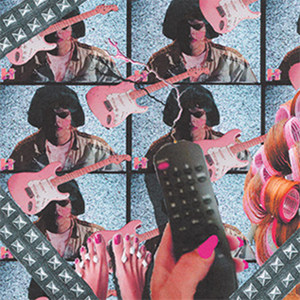Available on: Olde English Spelling Bee LP
Night Dolls With Hairspray is about nodes of ’80s popular culture that flout contemporary standards of taste and hygiene: the sleaze in Ferris Bueller’s wink, the sheen on Michael J. Fox’s forehead, the hum on Screech’s sneakers. James Ferraro invents new period indecencies and exaggerates them, moulds them into seedy, B-movie pop. ‘Leather High School’, the catchiest song here, plays out classic high-school movie scenarios, but shunts their barely concealed sexual subtext into the foreground. “The principal’s wearing panties under his suit”, Ferraro sings, his voice heliumed into a Garbage Pail falsetto, “they’re taking him down to the boiler room. They’re going to whip him till he bleeds”. Beneath him chunter a muffled drum machine and hair-metal power chords. ‘Buffy Honkerburg’s Answering Machine’ – all bubblegum surf licks and handclaps – rescreens some forgotten teen-slasher flick, with Ferraro as the nerd-creep leaving lascivious messages for an indifferent cheerleader.
It isn’t quite right to say Ferraro has finally delivered the pop record he’s always promised, but it almost is. Night Dolls is the most complete realisation of the pop-dabblings begun on the early Lamborghini Crystal albums. It’s the ossification of those disembodied riffs and Faltermeyer synth shapes from trippy allusion into an album that, heard from a next door room, nearly resembles the thing itself: there are verses, choruses, infectious hooks; there’s even a lyric sheet. Certainly it’s clear now, as it wasn’t before, that Ferraro is a great songwriter.
Up close, though, you can hear the holes; hear that Ferraro’s voice constantly creeps into the red, that he’s often sutured several, not-quite simpatico tapes into a single track. The chorus from the excellent, street-strutting “Nerd Killer” could have come from a different song entirely: it’s in a completely different mood and tempo to its ice-cool other half, with a high-strung, manically twung guitar riff and gerbil vocals. Then there are the interludes, disorienting amalgams of gross-out sound effects, shortwave radio noise, advertising jingles and cartoon theme tunes (“Roaches watch TV! Roaches watch TV!”). They’re bundles of loose signifiers, undefined entities; not products of the entertainment industry, but toxic by-products, symptoms.
The pop simulacrum Ferraro presents us with is porous, fissiparous, with splitting seams. The most obvious thing to say about it is that it provides a more accommodating alternative to the glistening chrome surfaces of contemporary MTV. It shows up how alien our idols are. Real teenagers, like Ferraro records, are smelly, acnefied, confused; while Beyonce is a slick, inhuman cyborg. But Ferraro shows us, too, how alien the ’80s have become. Partly because they were recorded onto corroding media – VHS, cassette, disintegrating vessels – making the memories progressively less accessible. But also because faultlines now show in the structure of movies, the gestures of actors, that weren’t visible originally. Back in the day, Ferris Bueller and Teen Wolf felt like valid fantasies, not kitsch artifacts. By magnifying textural imperfections and failings of taste Ferraro reminds us that these imperfections are there, but that we never used to see them. The entertainment industry, as it’s portrayed in Night Dolls, is a mirror in a state of constant dissolution; one that reflects a fantastical vision of the present that’s out of date and crumbling as soon as it’s realised – even as the vision hairpins to a blemishless space of muscled, digital geometry.
Nick Richardson





























